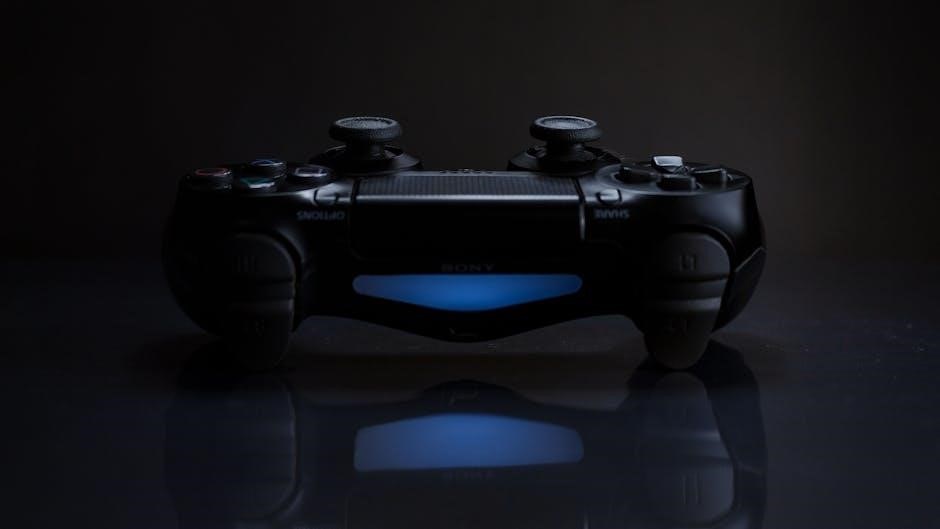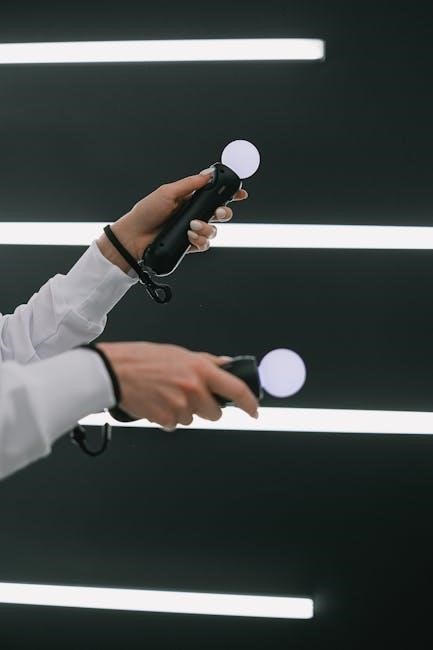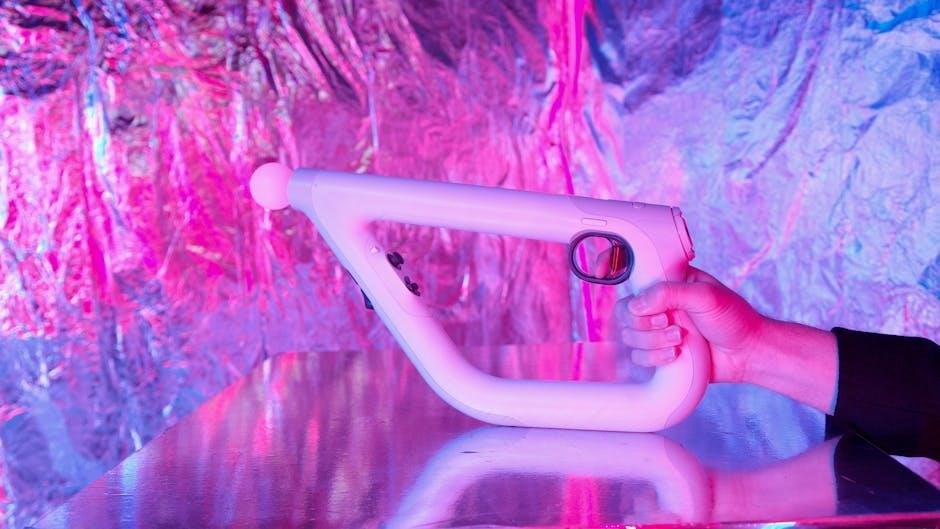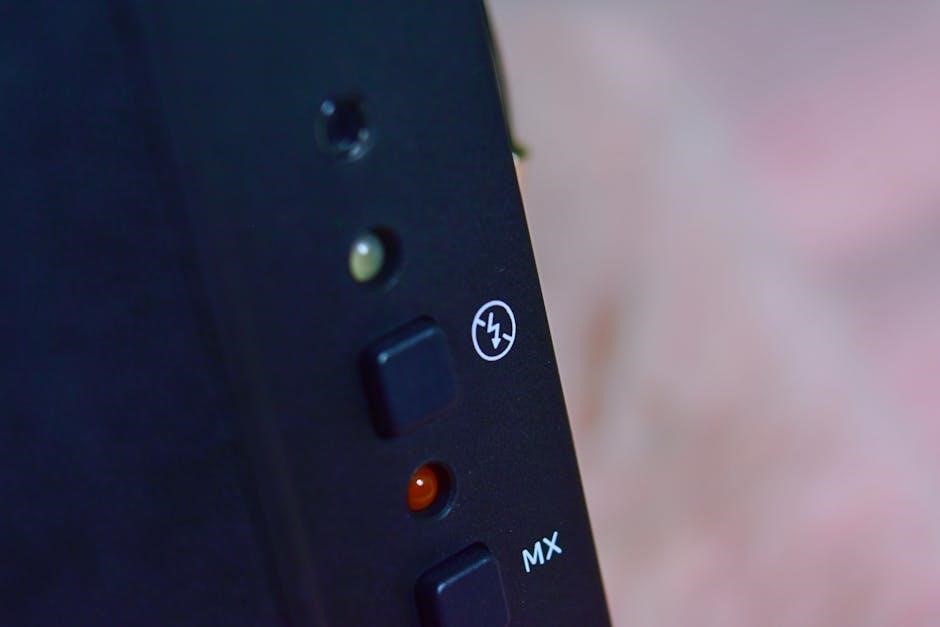Welcome to this comprehensive guide on LED strip remote control instructions. Learn how to operate, customize, and troubleshoot your LED lighting system for optimal performance and convenience. Discover essential functions, DIY tips, and advanced features to enhance your lighting experience.
Understanding the Basics of LED Strip Remote Controls
LED strip remote controls are essential for managing your lighting system efficiently. These remotes typically operate via infrared (IR) or radio frequency (RF), allowing you to adjust brightness, color, and modes. Basic functions include power toggling, dimming, and color changing. Some remotes also support DIY programming for custom scenes and effects. Understanding the frequency used by your LED strip is crucial for compatibility. IR remotes require line-of-sight, while RF remotes offer greater range and flexibility. Always ensure the remote is paired correctly with the receiver for seamless operation. Battery maintenance and proper signal reception are key to reliable performance. Explore these fundamentals to maximize your LED strip’s potential and enjoy a personalized lighting experience.
History and Evolution of LED Remote Controls
LED remote controls have evolved significantly over the years, from basic on/off switches to sophisticated devices offering advanced features. Early remotes were simple, with limited functionality, but advancements in technology introduced infrared (IR) and radio frequency (RF) capabilities. The rise of RGB LED strips further transformed remotes, enabling color mixing and dynamic effects. Modern remotes now support Wi-Fi and Bluetooth connectivity, allowing smartphone app control and voice commands via smart speakers. This evolution reflects the growing demand for smart home integration and personalized lighting experiences. The history of LED remote controls showcases continuous innovation, making lighting systems more accessible, versatile, and user-friendly than ever before.
Advantages of Using Remote Controls for LED Strips
Using remote controls for LED strips offers numerous benefits, enhancing convenience and flexibility in lighting management. Remotes allow users to adjust brightness, change colors, and switch modes without physical contact, making it ideal for hard-to-reach installations. They provide precise control over lighting effects, enabling seamless transitions between settings. Remote controls also support custom scenes and presets, saving users time and effort. Additionally, they often feature timers and scheduling options, improving energy efficiency. With the ability to control multiple strips from one device, remotes simplify complex lighting systems. Overall, remote controls elevate the user experience, offering versatility, ease of use, and enhanced customization for LED strip lighting.

Types of LED Strip Remote Controls
LED strip remotes include infrared (IR), radio frequency (RF), Wi-Fi, and Bluetooth models, offering different ranges and connectivity options for versatile applications.
Infrared (IR) vs. Radio Frequency (RF) Remotes
Infrared (IR) remotes use light signals and require a direct line of sight to the LED strip, limiting their range and flexibility. Radio Frequency (RF) remotes, on the other hand, use radio waves, offering longer range and the ability to control LED strips through walls or obstacles. IR remotes are simpler, more affordable, and suitable for basic setups, while RF remotes provide greater convenience and reliability for complex installations. Both types are widely used, but RF remotes are less prone to interference and offer better performance in multi-room environments. Choosing between IR and RF depends on the user’s specific needs, such as range requirements and setup complexity.
Dedicated Remotes vs. Universal Remotes
Dedicated remotes are specifically designed for a particular LED strip model, offering tailored functions and seamless compatibility. They are typically pre-programmed and require no setup, ensuring ease of use. Universal remotes, however, are designed to work with multiple devices, including various LED strip brands. While they offer flexibility, they may lack certain advanced features and often require programming to function correctly. Dedicated remotes are more reliable and user-friendly, while universal remotes provide versatility for those with multiple devices. The choice between the two depends on the user’s needs, with dedicated remotes being ideal for simplicity and universal remotes suited for broader compatibility.
Wi-Fi and Bluetooth-Enabled LED Remotes
Wi-Fi and Bluetooth-enabled LED remotes offer advanced wireless control, enabling users to manage their LED strips via smartphone apps. These remotes provide greater flexibility and range compared to traditional IR or RF models. With Wi-Fi, users can control LED strips from anywhere with an internet connection, while Bluetooth offers a reliable, short-range alternative. Both technologies support customizable settings, such as color, brightness, and scene selection, through dedicated apps. They also allow for seamless integration with smart home systems. However, they may require initial setup and can be more prone to interference. Despite this, Wi-Fi and Bluetooth remotes are ideal for modern, tech-savvy users seeking enhanced control and convenience.

Pairing and Programming the Remote Control
Pairing and programming involve syncing the remote with the LED strip. Turn on the strip, press the remote’s pairing button, and follow app instructions to complete setup.
How to Sync the Remote with the LED Strip
To sync the remote with your LED strip, start by turning on the LED strip and ensuring it is in pairing mode. Locate the pairing button on the remote, usually labeled as “Pair” or “Sync.” Press and hold this button until the remote’s indicator light flashes, signaling it is searching for devices. Next, press the pairing button on the LED strip controller or receptor. The remote will detect the strip and establish a connection. Once synced, the indicator light will stop flashing, and you can test the remote by adjusting settings like brightness or color. If the sync fails, ensure the remote has sufficient battery power and the strip is powered on. Repeat the process if necessary, and consult the manual if issues persist.
Programming Custom Colors and Scenes
Programming custom colors and scenes on your LED strip remote allows for personalized lighting experiences. Start by selecting a color from the remote’s color wheel or RGB settings. Adjust brightness and saturation to achieve the desired hue. For scenes, combine multiple colors or effects and save them as presets. Use the remote’s navigation buttons to cycle through options and confirm your selections. Once satisfied, save the configuration to a memory slot. Some remotes allow naming scenes for easy recall. Experiment with different combinations to create unique ambiance for various occasions. Test your customizations to ensure they function correctly. Refer to the remote’s manual for specific instructions, as programming steps may vary by model.
Saving and Recalling Preset Settings
Saving and recalling preset settings on your LED strip remote ensures quick access to your favorite configurations. To save, navigate to the desired color, brightness, or scene, then press and hold the “M” or “SET” button until it confirms. Assign the preset to a numbered slot, typically 1-6, depending on the remote. To recall, simply press the corresponding number key. Presets are stored in the remote’s memory, retaining your settings even when powered off. For dynamic scenes, some remotes allow saving multi-color transitions. Always test saved presets to ensure accuracy. If issues arise, reset the remote or refer to the manual. This feature enhances convenience, letting you enjoy customized lighting with minimal effort.

RGB LED Strip Remote Control Functions
RGB LED remotes enable vibrant color mixing, dynamic transitions, and customizable scenes. Adjust brightness, saturation, and speed for tailored effects. Program unique color combinations effortlessly with pre-set options.
Color Changing and Mixing
RGB LED strip remotes provide seamless color changing and mixing capabilities. Users can transition between millions of colors using preset options or custom combinations. The remote allows for smooth color transitions, enabling vibrant effects like gradual shifts or instantaneous changes. With RGB technology, users can mix red, green, and blue hues to create unique shades. Many remotes include a color wheel function, simplifying the selection process. Additionally, users can adjust the speed of color transitions to match their preferences. This feature is ideal for creating dynamic lighting effects, such as ambient room lighting or themed event setups. The ability to fine-tune colors and transitions ensures a personalized experience.
- Seamless color transitions for vibrant effects.
- Custom color mixing using RGB technology.
- Adjustable speed for dynamic lighting effects.
DIY Functions for Custom Lighting Effects
LED strip remotes often feature DIY functions that allow users to create unique lighting effects. These functions enable customization beyond preset settings, catering to individual preferences. Users can design custom scenes, combining colors, brightness, and effects to suit specific moods or environments. Some remotes offer macro controls, allowing multiple commands to be triggered with a single button press. This capability is particularly useful for creating complex lighting sequences or synchronized effects. Additionally, users can experiment with timing and transitions to craft dynamic displays. These DIY tools empower users to personalize their lighting experience, making it adaptable to various settings and occasions.
- Custom scene creation for unique lighting setups.
- Macro controls for complex command sequences.
- Adjustable timing and transitions for dynamic effects.
Controlling Multiple LED Strips with One Remote
Controlling multiple LED strips with a single remote enhances convenience and versatility. Many remotes support multi-channel or zone control, allowing users to manage different LED strips independently or simultaneously. This feature is ideal for large spaces or complex lighting setups; By assigning each strip to a specific channel, users can customize effects, colors, and brightness for each zone. Some remotes also enable synchronization across all strips for uniform lighting displays. This functionality is particularly useful for creating coordinated effects in home theaters, studios, or decorative installations. Multi-strip control simplifies operation and elevates the overall lighting experience.
- Independent or synchronized control of multiple strips.
- Zone-based management for tailored lighting effects.
- Ideal for large or multi-functional spaces.

Troubleshooting Common Issues
Troubleshooting common issues with LED strip remotes involves diagnosing connectivity, battery, and interference problems. Regular checks ensure smooth operation and resolve most glitches effectively.
- Check battery strength and connections.
- Ensure proper signal reception.
- Inspect for interference sources.
Remote Control Not Responding
If your LED strip remote isn’t responding, start by checking the batteries. Ensure they are properly inserted and not depleted. Weak or dead batteries often cause connectivity issues. Next, verify that the remote’s infrared (IR) sensor is clean and unobstructed. Dirt or blockages can prevent signals from being transmitted. Also, check the distance between the remote and the receiver; ensure it’s within range. If using RF or Wi-Fi models, interference from other devices might be the culprit. Restart both the remote and LED strip, and ensure they are paired correctly. If issues persist, consult the user manual or contact support for further assistance.
Fixing Connectivity Problems
Connectivity issues with LED strip remotes can often be resolved by ensuring a stable connection. First, check the distance between the remote and receiver, as signals may weaken over long ranges. For RF or Wi-Fi models, interference from other electronic devices can disrupt communication. Restarting both the remote and LED strip can help re-establish the connection. Ensure the remote is properly paired with the strip by following the pairing procedure in the manual; If using a Wi-Fi or Bluetooth remote, confirm the LED strip is connected to the correct network. Finally, updating the remote’s firmware or resetting it to factory settings may resolve persistent connectivity problems.
Resolving Interference Issues

Interference is a common issue that can disrupt LED strip remote control functionality. To resolve this, identify the source of interference, such as nearby electronic devices or physical barriers. Move the remote and LED strip away from devices emitting similar frequencies. For RF or Wi-Fi remotes, switching to a different frequency channel may help. Ensure there are no obstructions between the remote and receiver, as physical barriers can weaken the signal. If using a universal remote, check for conflicts with other devices. Additionally, updating the remote’s firmware can improve signal stability. Regularly cleaning the remote’s sensors and ensuring proper battery power can also minimize interference-related problems.

Maintenance and Care
Regularly clean the remote with a soft cloth to prevent dirt buildup. Replace batteries promptly when low, and store the remote in a dry place. Ensure the IR sensor is unobstructed and update software periodically for optimal performance.
Cleaning the Remote Control
Regular cleaning of your LED strip remote control is essential for maintaining its functionality. Use a soft, dry cloth to wipe the surface, paying attention to buttons and crevices where dust accumulates. For stubborn dirt, lightly dampen the cloth with water, but avoid excessive moisture to prevent damage. Never use harsh chemicals or abrasive cleaners, as they may harm the finish or electronics. Gently scrub the infrared (IR) sensor to ensure clear signal transmission. After cleaning, dry the remote thoroughly with a clean cloth. Avoid exposing the remote to direct sunlight or moisture for extended periods. Proper maintenance ensures reliable performance and extends the lifespan of your remote control.
Replacing Batteries
Replacing the batteries in your LED strip remote control is a straightforward process. First, check the battery type specified in the manual, typically AAA or CR2025. Open the battery compartment, usually located on the back, by sliding it off or using a small screwdriver. Remove the old batteries and insert the new ones, ensuring the positive (+) and negative (-) terminals align correctly. Avoid mixing old and new batteries or using different types. Once replaced, close the compartment securely. Dispose of used batteries responsibly. If the remote lacks battery compartment screws, gently pry it open with care. Turn the remote off before replacing batteries to ensure proper reset. Test the remote afterward to confirm functionality. Regular replacement ensures consistent performance and prevents signal issues.
Updating Firmware
Updating the firmware of your LED strip remote control is essential for ensuring optimal performance and accessing new features. Begin by connecting the remote to your computer using a USB cable. Download the latest firmware version from the manufacturer’s official website. Use the provided software tool to install the update. Do not disconnect the remote during the update process, as this could cause permanent damage. Once completed, test the remote to verify all functions work correctly. Regular firmware updates improve compatibility, fix bugs, and enhance user experience. Always follow the manufacturer’s instructions to avoid errors. If issues arise, consult the user manual or contact customer support for assistance.

Compatibility and Replacement
Ensuring compatibility and having replacement options are crucial for maintaining LED strip functionality. This section guides you through selecting the right remote and ensuring seamless operation.
How to Check Compatibility with Your LED Strip
To ensure smooth operation, verify that your remote control is compatible with your LED strip. Start by checking the remote’s technology type (IR, RF, Wi-Fi, or Bluetooth) and ensure it matches the LED strip’s receiver. Next, review the LED strip’s specifications, such as the number of channels (e.g., RGB, RGBW, or single color) and voltage requirements. If using a universal remote, consult the user manual or manufacturer’s website for a list of supported LED strip models. Additionally, confirm that the remote’s frequency or communication protocol aligns with the LED strip’s controller. For smart LED strips, check app compatibility and ensure your device supports the required connectivity standards. Testing the remote with the LED strip is the final step to confirm proper functionality.
Replacing a Lost or Damaged Remote
If your LED strip remote is lost or damaged, replacing it is straightforward. First, identify the type of remote you need by checking the LED strip’s specifications, such as IR, RF, Wi-Fi, or Bluetooth compatibility. Purchase a replacement remote from the original manufacturer or a trusted supplier, ensuring it matches your LED strip’s model and functionality. If the exact remote is unavailable, consider a universal remote designed for your LED strip type. Before buying, consult the user manual or contact customer support for compatibility confirmation. Once the new remote arrives, follow the pairing instructions provided with the LED strip to synchronize it. Always purchase from authorized dealers to avoid counterfeit products. Testing the remote immediately after pairing ensures proper functionality.
Using Third-Party Remote Controls
Using third-party remote controls for LED strips can be a viable option if the original remote is unavailable. These remotes are designed to work with a variety of LED strip brands and models, offering flexibility and convenience. Before purchasing, ensure the third-party remote is compatible with your LED strip’s technology, such as IR, RF, or Wi-Fi. Compatibility can usually be verified by checking the product description or contacting the seller. Some third-party remotes may offer additional features like app control or voice integration, enhancing functionality. However, they might lack some advanced features of the original remote. Always follow the manufacturer’s instructions for pairing and programming to ensure seamless operation. Third-party remotes can be a cost-effective and reliable solution for controlling your LED strips effectively.

Advanced Features
Advanced features include app control, voice integration, and smart home compatibility, enabling seamless LED strip customization and automation for enhanced user convenience and lighting experiences.
- App control for remote adjustments
- Voice command functionality
- Smart home system integration
- Customizable effects
- Scheduling capabilities
Using Apps for Remote Control
Using apps for remote control offers enhanced functionality and convenience. Many LED strip remotes connect to dedicated apps, allowing users to adjust colors, brightness, and effects via smartphones or tablets. These apps often provide advanced features like custom scene creation, scheduling, and synchronization with music or videos. Compatibility varies, with some apps supporting both iOS and Android devices. Before use, ensure the app is downloaded from trusted sources like the App Store or Google Play. Pairing the LED strip with the app typically involves Bluetooth or Wi-Fi connectivity. Once connected, users can explore preset modes, create personalized lighting schemes, and even share settings with others. This method is ideal for those seeking greater control and flexibility beyond traditional remote functions.

Integration with Smart Home Systems
Integrating LED strip remote controls with smart home systems enhances convenience and customization. Systems like Alexa, Google Home, or Apple HomeKit enable voice control, allowing users to adjust lighting without physical remotes. This integration also permits synchronized lighting effects with other smart devices, creating a unified smart home experience. Compatibility varies, so ensure your LED strip and remote support smart home systems. Many modern remotes come with built-in compatibility, while others require hubs or bridges. Setup typically involves linking devices through the smart home app. This feature is ideal for those seeking hands-free control and seamless integration with existing smart technology. Always check compatibility before purchasing to ensure smooth operation.
Voice Control via Smart Speakers
Voice control via smart speakers like Amazon Alexa or Google Home offers a hands-free way to manage LED strip lighting. Users can adjust brightness, change colors, or activate scenes using voice commands. This feature is particularly convenient for creating ambiance without needing a physical remote. Compatibility with smart speakers varies, so ensure your LED strip and remote support voice control. Setup typically involves linking the LED system to the smart speaker via an app. Commands like “Dim the living room lights to 50%” or “Change the LED strips to blue” simplify control. Voice integration enhances accessibility and modernizes lighting management, making it a popular choice for smart home enthusiasts. Always check compatibility before setup for optimal performance.
Mastering LED strip remote controls enhances lighting experiences. With proper setup and care, users can create ambiance, customize settings, and enjoy seamless control. Future updates promise even greater convenience.
Best Practices for Using LED Strip Remotes
- Always read the manual to understand remote-specific functions and compatibility.
- Regularly clean the remote to prevent dirt from affecting button responsiveness.
- Test all buttons and features after pairing to ensure proper functionality.
- Store the remote in a dry, cool place to avoid damage from moisture or heat.
- Replace batteries promptly when low to maintain consistent performance.
- Update firmware if available to access new features and improvements.
- Avoid exposing the remote to direct sunlight or extreme temperatures.
- Use the remote within the recommended range to ensure reliable connectivity.
- Label custom scenes or presets for easy recall and convenience.
- Experiment with settings gradually to avoid overwhelming the system.
By following these practices, users can maximize the performance and longevity of their LED strip remotes.
Safety Tips for Remote-Controlled LED Strips
- Avoid exposing LED strips to water or moisture to prevent electrical hazards.
- Keep the remote and LED strips out of reach of children and pets.
- Ensure proper ventilation to avoid overheating during prolonged use.
- Disconnect power before handling or installing LED strips.
- Use the correct voltage rating for your LED strips to prevent damage or fire risks.
- Avoid touching electrical components with wet hands or while standing on conductive surfaces.
- Do not overload circuits or power supplies with excessive LED strip connections.
- Regularly inspect wires and connections for damage or wear.
- Keep flammable materials away from LED strips, as they may generate heat.
- Dispose of batteries and electronic components responsibly.
Following these safety tips ensures a secure and reliable experience with remote-controlled LED strips.
Future Trends in LED Remote Control Technology
The future of LED remote control technology is set to revolutionize lighting systems with cutting-edge innovations. One prominent trend is the integration of voice control, allowing users to adjust settings via smart speakers. Gesture control is another emerging feature, enabling intuitive operation with hand movements. Advanced color customization will permit dynamic lighting effects, while energy-efficient technologies optimize power usage. Enhanced wireless connectivity promises reliable long-range control, minimizing interference; Biometric authentication could offer personalized lighting preferences. Additionally, health-centric lighting aligned with circadian rhythms is expected to improve well-being. Finally, eco-friendly materials and sustainable practices will reduce the environmental footprint of LED remote controls. These advancements aim to enhance functionality, convenience, and sustainability, shaping the future of LED lighting control.
Comments